
The Nectriaceae comprise a family of fungi in the order Hypocreales. It was circumscribed by brothers Charles and Louis René Tulasne in 1865. In 2020, an Outline of fungi was produced and listed 70 genera and about 1,336 species.
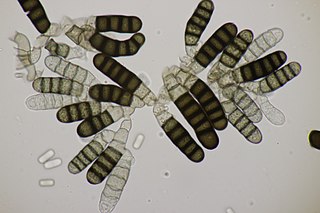
Thielaviopsis is a small genus of fungi in the order Microascales, and family Ceratocystidaceae. The genus includes several important agricultural based pathogens. The most widespread is T. basicola, the causal agent in several root rot diseases of economically important crop species including cotton and a variety of vegetables. In cotton, Thielaviopsis causes root rot, also known as black root rot, which causes necrosis of the roots and stunting of the crop plants.
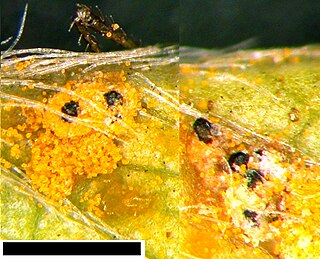
The Phaeosphaeriaceae are a family of fungi in the order Pleosporales. Species in the family have a cosmopolitan distribution, and are generally nectrotrophic or saprobic on a wide range of plants.
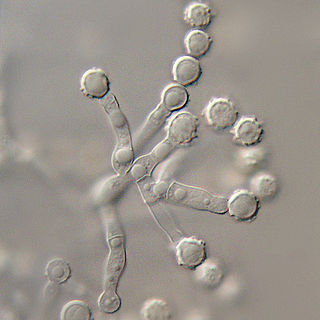
The Microascaceae are a family of fungi in the class Sordariomycetes, subclass Hypocreomycetidae. The family was published by David Malloch in 1970, an emended description based on Everet Stanley Luttrell's original 1951 publication. Family was updated in 2020.
Phaeosphaeriopsis is a genus of fungi in the family Phaeosphaeriaceae.
Teratosphaeria is a genus of fungi in the family Teratosphaeriaceae; according to the 2007 Outline of Ascomycota, it was placed in the Phaeosphaeriaceae, but the placement within this family was uncertain. It was confirmed in 2020, within Teratosphaeriaceae by Wijayawardene et al. 2020.

Herpotrichiellaceae is a family of ascomycetous fungi within the order Chaetothyriales and within the class Eurotiomycetes. It contains 16 genera and about 270 species. The type genus of the family, Herpotrichiella, is now synonymous with Capronia.
The Chaetosphaeriales are an order of fungi within the class Sordariomycetes.
The Planistromellaceae are a family of fungi, with in the class of Botryosphaeriales.

The Chaetosphaeriaceae are a family of fungi in the Ascomycota, class Sordariomycetes. The family was circumscribed by Martina Réblová, Margaret Elizabeth Barr Bigelow, and Gary Samuels in 1999. Species in the family have a cosmopolitan distribution, and are found in both temperate and tropical climates. Fossils of the Chaetosphaeriaceae are known from the Carboniferous, Eocene, Oligocene, Miocene and more recent sediments.

The Ophiostomataceae are a family of fungi in the Ascomycota, class Sordariomycetes. The family was circumscribed by J.A. Nannfeldt in 1932. Species in the family have a widespread distribution, and are typically found in temperate regions, as pathogens of both coniferous and deciduous trees.
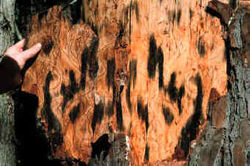
Ophiostoma is a genus of fungi within the family Ophiostomataceae. It was circumscribed in 1919 by mycologists Hans Sydow and Paul Sydow.
Graphium is a genus of fungi in the family Microascaceae. Historically, Graphium was used for hyphomycetes with erect, black synnemata bearing a single, terminal, ball of one-celled, hyaline conidia produced from annellides. More than 100 species were described following that general concept before the diversity of sexual states and DNA phylogenies led to reclassification of most species. The approximately 20 species remaining in the modern genus are assumed to be minor plant pathogens on trees. Most species reported in soil, plant debris, woody substrates, manure, and polluted water are now classified in other genera such as Parascedosporium or Ophiostoma.
Endoconidiophora is a genus of fungi within the Ceratocystidaceae family.
Gabarnaudia is a genus of anamorphic fungi that was placed in the family Ceratocystidaceae, until phylogenetic analysis by Hausner and Reid (2004) and De Beer et al. (2013a) showed that Gabarnaudia fimicolaG. betae and G. humicola clustered within genus Sphaeronaemella.
Togniniaceae is family of fungi in the order Togniniales.

Sporothrix is a ubiquitous genus of soil-dwelling fungus discovered by Schenck in 1898, and studied in more detail by Hektoen and Perkins. The first described and best known species is Sporothrix schenckii, the causative agent of rose handler's disease. New environmental, and pathogenic, species have been discovered with the potential for more to be found as molecular techniques advance.
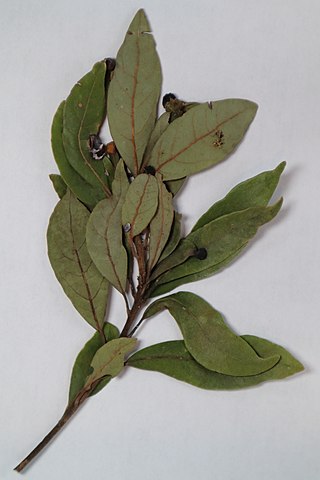
Raffaelea is a genus of ambrosia fungi in the family Ophiostomataceae. It was circumscribed by mycologists Josef Adolph von Arx and Grégoire L. Hennebert in 1965 with Raffaelea ambrosiae as the type species. The genus is named in honor of Italian botanist Raffaele Ciferri.

The Stachybotryaceae are a family of fungi in the order Hypocreales; the genera it contains have been described as "hyper-diverse".

Neocamarosporium is a genus of ascomycete fungi, as accepted by Wijayawardene et al. 2020. The species are typically halotolerant, being commonly found in saline environments like in saline water, hypersaline soils and especially in association with halophytes.











